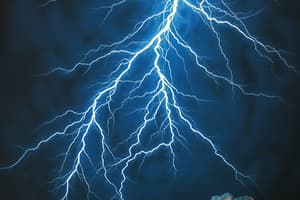Podcast
Questions and Answers
Which of the following statements accurately describes the behavior of electric charges?
Which of the following statements accurately describes the behavior of electric charges?
- Like charges repel, while unlike charges attract. (correct)
- The total charge in an isolated system varies over time.
- Like charges attract, while unlike charges repel.
- Electric charges can be created or destroyed within a closed system.
Insulators facilitate the free movement of electric charges, making them ideal for conducting electricity.
Insulators facilitate the free movement of electric charges, making them ideal for conducting electricity.
False (B)
Explain the principle of charge conservation and its significance within an isolated system.
Explain the principle of charge conservation and its significance within an isolated system.
The principle of charge conservation states that the total charge in an isolated system remains constant over time. Charges cannot be created or destroyed, only transferred from one object to another, ensuring the total charge of the system is always conserved.
According to Coulomb's Law, the electrostatic force between two point charges is ______ proportional to the square of the distance between them.
According to Coulomb's Law, the electrostatic force between two point charges is ______ proportional to the square of the distance between them.
Match the following terms related to electric charge with their correct descriptions:
Match the following terms related to electric charge with their correct descriptions:
Which phenomenon is primarily responsible for the crackling sound and sparks observed when removing synthetic clothes during dry weather?
Which phenomenon is primarily responsible for the crackling sound and sparks observed when removing synthetic clothes during dry weather?
Electrostatics is the branch of physics that specifically studies the motion of electric charges and their dynamic interactions.
Electrostatics is the branch of physics that specifically studies the motion of electric charges and their dynamic interactions.
What fundamental law describes the force between two charged objects, a key concept in understanding electric forces?
What fundamental law describes the force between two charged objects, a key concept in understanding electric forces?
The principle used to calculate the overall electric field resulting from multiple charges is known as the ________ principle.
The principle used to calculate the overall electric field resulting from multiple charges is known as the ________ principle.
Match each term with its correct description:
Match each term with its correct description:
Flashcards
Electrostatics
Electrostatics
The study of forces, fields, and potentials arising from static electric charges.
Static Electricity
Static Electricity
The accumulation of electric charges on insulating surfaces through contact or rubbing.
Coulomb's Law
Coulomb's Law
Describes the force between two charged objects; force is proportional to the magnitude of charges and inversely proportional to the square of the distance.
Superposition Principle (Electric Fields)
Superposition Principle (Electric Fields)
Signup and view all the flashcards
Electric Field Lines
Electric Field Lines
Signup and view all the flashcards
Electric Charge
Electric Charge
Signup and view all the flashcards
Conductors
Conductors
Signup and view all the flashcards
Insulators
Insulators
Signup and view all the flashcards
Quantization of Charge
Quantization of Charge
Signup and view all the flashcards
Study Notes
- Crackling sounds or sparks when removing synthetic clothes, and lightning, are due to the discharge of accumulated electric charges.
- These charges build up through rubbing insulating surfaces together, in a process is known as static electricity.
- Electrostatics, a branch of physics, studies forces, fields, and potentials from static charges.
Electric Charge
- The term 'electricity' originates from the Greek word "Elektron," meaning amber.
- Ancient Greeks observed that rubbing amber generated static electricity.
- Electric charge is a fundamental property of matter that influences how atoms and molecules interact: Positive charge Negative charge
- Like charges repel, while unlike charges attract each other, an idea is known as polarity of charge.
Conductors and Insulators
- Conductors allow electric charges to move freely, enabling them to carry electricity easily (metals, the Earth, and the human body).
- Insulators resist the flow of electric charges, preventing electrical flow (porcelain, nylon, and wood).
Properties of Electric Charge
- Electric charge exhibits three key properties:
- Quantization: Total charge is an integer multiple of a basic unit.
- Additivity: Total charge is the algebraic sum of individual charges
- Conservation: Total charge in an isolated system remains constant.
Coulomb's Law
- Describes electrostatic force between two point charges.
- If two stationary point charges, Q1 and Q2, are separated by a distance r, the magnitude of the electrostatic force F is FBA = k(AB) ÷ r²AB
- Direction of Force: The force acts along the line joining the two charges.
- Nature of Force:
- Repulsive: Charges are of the same sign
- Attractive: Charges are of opposite signs
- Conservative Nature: Work done moving a charge between two points is independent of the path taken
- Inverse Square Law: The force decreases with the square of the distance
Forces Between Multiple Charges
- Coulomb's law calculates the interactions between any two charges.
- Calculate the vector sum of individual forces to determine net force with multiple charges, known as the superposition principle.
Superposition Principle
- The interaction between two charges is not influenced by other charges.
Properties of Electric Field Lines
- Continuous Curves: Lines are continuous without breaks in regions without charges
- No Intersection: Two lines never cross
- Starting and Ending Points: Lines originate from positive charges and terminate on negative charges
- No Closed Loops: Electrostatic field lines never form closed loops
Electric Flux
- Refers to the total number of electric field lines passing through a given area.
Electric Flux Formula
- The electric flux Δ0 through a small area element AS is given by: Δ0= Ε.ΔS= E AS cosθ
- E is the electric field strength
- AS is the area element
- 0 is the angle between the electric field E and the normal
Electric Dipole
- Two equal and opposite charges (+q and -q) separated by a distance
- Dipole moment is p=q*2a
- Distance between the charges is represented as 2a, and the vector direction goes from negative to positive charge.
Charge on a Capacitor
- The net charge on a capacitor is always zero
- The charge Q is the magnitude of the charge on one of the plates.
Properties of an Ideal Battery
- Includes:
- Two Terminals, one positive and one negative
- Constant Potential Difference that remains constant regardless of the load connected to it.
Electromotive Force (EMF)
- The fixed potential difference between battery terminals
- When a conductor connects to a terminal, the potential of the conductor matches that of the terminal
- If capacitor plates connect the terminals, the potential difference becomes equal to the emf
Charge Conservation
- The total remains 0.
Benefits of CBSE Class 12 Physics Notes Chapter 1 Electric Charges and Fields
- Conceptual Understanding: Simplified explanation of electric charges, Coulomb's law, and electric fields
- Concise Summary: Key points in a manageable format
- Enhanced Retention: Highlights essential concepts and formulas
- Effective Revision Tool: Quick reference for exam preparation
- Comprehensive Coverage: Definitions, laws, properties, and applications
Studying That Suits You
Use AI to generate personalized quizzes and flashcards to suit your learning preferences.



